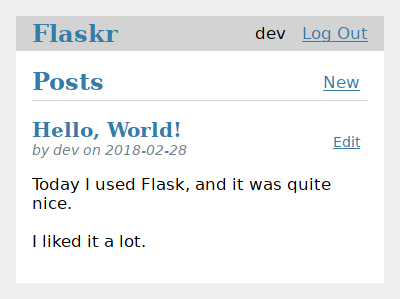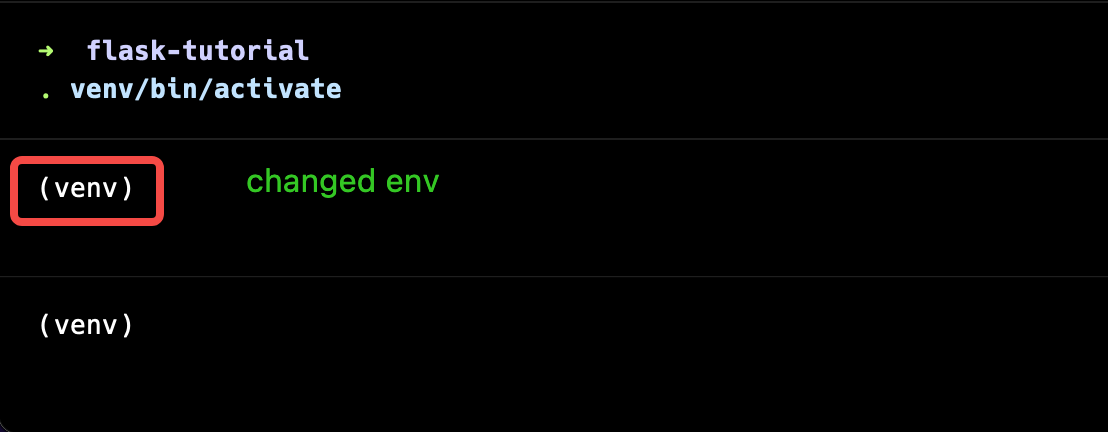Reference
Flask Installation
Flask Tutorial
Follow the tutorial to build a blog web app like:
Step by Step
Step 0.Backgroud
build a basic blog application called Flaskr using Flask.
Step 1. Project Layout
Create a project directory
mkdir flask-tutorialcd flask-tutorial/
复制代码
Install Flask
Flask Installation Doc
Create an python environment using venv:
$ python3 -m venv venv
$ tree . -L 3.└── venv ├── bin │ ├── Activate.ps1 │ ├── activate │ ├── activate.csh │ ├── activate.fish │ ├── pip │ ├── pip3 │ ├── pip3.9 │ ├── python -> python3 │ ├── python3 -> /Users/yangls06/opt/miniconda3/bin/python3 │ └── python3.9 -> python3 ├── include ├── lib │ └── python3.9 └── pyvenv.cfg
5 directories, 11 files
$ tree venv/lib/python3.9/ -L 3venv/lib/python3.9/└── site-packages ├── _distutils_hack │ ├── __init__.py │ ├── __pycache__ │ └── override.py ├── distutils-precedence.pth ├── pip │ ├── __init__.py │ ├── __main__.py ... ├── pkg_resources ...
复制代码
Activate the environment
Then the environment has been changed.
Install Flask
Within the activated environment, install Flask using pip:
$ pip install Flask
Looking in indexes: https://pypi.douban.com/simpleCollecting Flask Downloading https://pypi.doubanio.com/packages/0f/43/15f4f9ab225b0b25352412e8daa3d0e3d135fcf5e127070c74c3632c8b4c/Flask-2.2.2-py3-none-any.whl (101 kB) ━━━━━━━━━━━━━━━━━━━━━━━━━━━━━━━━━━━━━━━━ 101.5/101.5 KB 1.8 MB/s eta 0:00:00...Collecting MarkupSafe>=2.0 Downloading https://pypi.doubanio.com/packages/06/7f/d5e46d7464360b6ac39c5b0b604770dba937e3d7cab485d2f3298454717b/MarkupSafe-2.1.1-cp39-cp39-macosx_10_9_universal2.whl (17 kB)Installing collected packages: zipp, MarkupSafe, itsdangerous, click, Werkzeug, Jinja2, importlib-metadata, FlaskSuccessfully installed Flask-2.2.2 Jinja2-3.1.2 MarkupSafe-2.1.1 Werkzeug-2.2.2 click-8.1.3 importlib-metadata-5.1.0 itsdangerous-2.1.2 zipp-3.11.0
复制代码
Git init
with .gitignore
venv/
*.pyc__pycache__/
instance/
.pytest_cache/.coveragehtmlcov/
dist/build/*.egg-info/
复制代码
Add folders
$ tree -a -L 1.├── .git├── .gitignore├── flaskr├── tests└── venv
4 directories, 1 file
复制代码
Step 3. Application Setup
The Application Factory: _init_.py
#!/usr/bin/env python# -*- encoding: utf-8 -*-
"""@Time : 2022/12/01 15:58:24@Author : Linsan Yang @Desc : init flaskr"""
import osfrom flask import Flask
def create_app(test_config=None): # create and configure the app app = Flask(__name__, instance_relative_config=True) app.config.from_mapping( SECRET_KEY = 'dev', DATABASE=os.path.join(app.instance_path, 'flaskr.sqlite'), )
if test_config is None: # load the instance config, if it exists, when not testing app.config.from_pyfile('config.py', silent=True) else: # load the test config if passed in app.config.from_mapping(test_config) # ensure the instance folder exists try: os.makedirs(app.instance_path) except OSError as e: pass
# a simple page that says hello @app.route('/hello') def hello(): return 'Hello, World!'
return app
复制代码
instance folder
There will be a instance/directory, located outside the flaskr package and can hold local data that shouldn’t be committed to version control, such as configuration secrets and the database file.
test_config
Using test_config for testing.
@app.route()
create a simple route of /hello
Run The Application
In the flask-tutorial dir not flaskr package:
$ flask --app flaskr --debug run * Serving Flask app 'flaskr' * Debug mode: onWARNING: This is a development server. Do not use it in a production deployment. Use a production WSGI server instead. * Running on http://127.0.0.1:5000Press CTRL+C to quit * Restarting with stat * Debugger is active! * Debugger PIN: 134-914-837
复制代码
Then open 127.0.0.1:5000/hello in browser, got
Step 4. Define and Access the Database
The app will use Sqlite database to store users and posts. Python has a built-in module sqlite3 module.
Connect to Sqlite
flaskr/db.py
import sqlite3
import clickfrom flask import current_app, g
def get_db(): if 'db' not in g: g.db = sqlite3.connect( current_app.config['DATABASE'], detect_types=sqlite3.PARSE_DECLTYPES ) g.db.row_factory = sqlite3.Row return g.db
def close_db(e=None): db = g.pop(db, None)
if db is not None: db.close()
复制代码
g is a spectial object for each request to share data among different functions. current_app is similar.
Create Tables: using sql
Define user and post table in flaskr/schema.sql:
DROP TABLE IF EXISTS user;DROP TABLE IF EXISTS post;
CREATE TABLE user ( id INTEGER PRIMARY KEY AUTOINCREMENT, username TEXT UNIQUE NOT NULL, password TEXT NOT NULL);
CREATE TABLE post ( id INTEGER PRIMARY KEY AUTOINCREMENT, author_id INTEGER NOT NULL, created TIMESTAMP NOT NULL DEFAULT CURRENT_TIMESTAMP, title TEXT NOT NULL, body TEXT NOT NULL, FOREIGN KEY (author_id) REFERENCES user (id));
复制代码
Add functions to run the SQLs to the db.py
def init_db(): db = get_db() with current_app.open_resource('schema.sql') as f: db.executescript(f.read().decode('utf8'))
@click.command('init-db')def init_db_command(): '''Clear the existing data and create new tables.''' init_db() click.echo('Initialized the database.')
复制代码
Register with the Applicaiton
The close_db and init_db_command functions need to be registered with the app instance for use.
In db.py add a new init_app function:
def init_app(app): # tells Flask to call that function when cleaning up after returning the response app.teardown_appcontext(close_db) # adds a new command that can be called with the flask command app.cli.add_command(init_db_command)
复制代码
Then import and call this function from the factory in __init__.py.
def create_app(test_config=None): # create and configure the app app = ... # existing code omitted # add db functions from . import db db.init_app(app)
return app
复制代码
Initialize the Database
Now use init-dbcommand like this:
$ flask --app flaskr init-dbInitialized the database.
$ tree instance/instance/└── flaskr.sqlite
0 directories, 1 file
复制代码
The command generates a sqlite db file flaskr.sqlite in instance/ dir.













评论